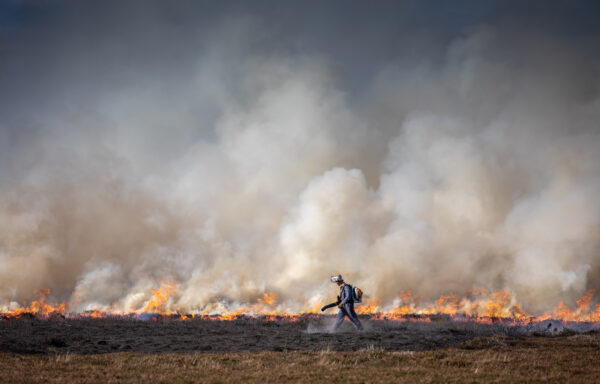Environmental campaigners are urging the UK government to bolster measures to protect peatlands from being damaged by the grouse shooting industry, following the conclusion of the moorland burning season.
Wild Moors, an organisation which monitors protection of peatlands in the UK’s uplands, has documented over 360 instances of burning conducted by grouse moors on peatlands between October 1 and April 15. The actual amount of burning which took place is believed to be higher, despite the 2023 – 2024 burning season being restricted by extremely wet weather.
Peatland is the UK’s largest carbon store on land, locking in an estimated 3.2 billion tonnes of carbon. When these habitats are burned they degrade and release stored carbon, converting from being carbon sinks to significant carbon sources.
The primary reason for burning heather on grouse moors is to provide younger, fresher vegetation that serves as food for game birds, which are targeted by sports shooting parties.
Luke Steele, Executive Director of Wild Moors, said: “Grouse moors fan the flames of climate change by setting carbon-rich peatlands ablaze despite this making it difficult, if not impossible, to protect and restore these important ecosystems to prevent them from collapse.
“Wild Moors is urging the government to extinguish grouse moor fires once and for all by introducing a complete ban on burning peatlands.”
In 2021, the government enacted restrictions to limit the burning of peat moorlands, acknowledging the environmental harm caused by the practice. However, these regulations are limited to deep peat areas – those exceeding 40 cm in depth and located within protected areas – leaving shallow peatlands vulnerable despite their need for restoration to a healthier, deeper state.
The Climate Change Committee, an independent advisor to the government, has recommended prohibiting all rotational burning on peatlands to achieve carbon net zero, and warns that burning on any depth “is highly damaging to the peat, and to the range of environmental benefits that well-functioning peat can deliver”.
Although most of the burning recorded by Wild Moors were legal, occurring on peatlands exempt from the rules, many took place within some of the UK’s most important upland nature sites. This includes inside the iconic North York Moors, Yorkshire Dales and Peak District national parks.
There were also a number of suspected illegal burns on protected deep peatlands, in apparent violation of the rules.
The environmental concerns linked to moorland burning extend beyond damage to peatland ecosystems. In October, significant burning on the outskirts of Sheffield enveloped large parts of the city in acrid smoke. This led to significant complaints from residents about air quality and adverse health effects and prompted local leaders, including the Mayor of South Yorkshire and the leader of Sheffield Council, to call for a complete ban on the practice.
Luke Steele added: “Most people want to see the environment given the protection it needs and deserves, so it’s time to bring an end to harmful practices like burning on peat moorlands for grouse shooting and instead restore these treasured landscapes for nature, the climate and people.”
Image credit: Steve Morgan / Greenpeace
Peatlands remain at risk from grouse moor burning, nature campaigners warn
